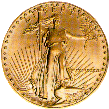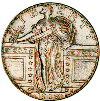 The Coin Page
The Coin Page 
I've been collecting coins on and off since my childhood.
For the last year or so, I've been actively collecting coins from
circulation (i.e. pocket change), obtaining change at face value and
looking through it for any keepers and spending the rest.
Here are some of the more interesting finds I've managed to turn up
in my search:
- A 1960 small-date Lincoln cent (worth about $1)
- A 1995 doubled-die obverse Lincoln cent (worth about $30)
- A 1929 Buffalo nickel (worth about $.50)
- A 1950-D Jefferson nickel (worth about $5)
- A 1946 (silver) Roosevelt dime (worth about $.60)
- A 1972-S proof Roosevelt dime (worth about $1)
- A 1962 (silver) Canadian quarter (worth about $.80)
- A 1958-D (silver) Franklin half-dollar (worth about $2.00)
- A 1963-D (silver) Franklin half-dollar (worth about $2.00)
- A 1976-S proof Bicentennial half-dollar (worth about $1.25)
- A 1986-S proof Kennedy half-dollar (worth about $15)
- A 1973 Eisenhower dollar (worth about $1.50)
- A 1981-S Susan B Anthony dollar (worth about $2)
(NOTE: I use the term nickel to denote the usual 5-cent piece)
There are more common, but still collectible, coins that I have found without
too much difficulty:
- Old Lincoln cents - I've found ones dated 1911, 1916, 1917-D, 1918, 1924
and so on. They're generally worth $.50 to $1, unless you happen to find
a rare date/mintmark or one in exceptional condition.
- 1960-D small-date Lincoln cents - They're more common than the 1960
(no D) small-date cents, so they're only worth about $.25 each. I've found
four of them already.
- All 7 varieties of 1982 Lincoln cents - This is tougher than it sounds.
Even after figuring out how to distinguish between large and small dates
(pay attention to the "2") and between copper and zinc coins (weigh them),
one discovers that some varieties are much scarcer than others. How else
could shops get away with charging $2 or more for a set of seven cents?
- Dateless Buffalo nickels - Buffalo nickels have an awful tendency to
lose their dates through circulation wear. Nickels without a date aren't
worth all that much, but they still look pretty neat.
- Wartime silver nickels (1942-1945) - Most of them look unusually gray
and have a big mintmark (P, D, or S) above the dome in back.
I've found about a dozen of them - a 1942-P, 2 1943-Ps, a 1943-S, a 1944-P,
4 1945-Ps, a 1945-D, and 2 1945-Ss.
These tend to be worth $.30 to $1, depending on condition.
- Silver half-dollars - Kennedy halves dated 1965-1970 are 40% silver,
while those dated 1964 are 90% silver. Anything dated before that
(e.g. Franklin halves) are also 90% silver. The 40% silver pieces turn up
surprisingly often in circulation, while the 90% ones are a bit trickier
to find. I've amassed over 200 of the 40% silver halves and 18 of the
90% silver halves (two Franklins, the rest 1964 Kennedys).
At the current price of silver, 40% coins are worth
1.5x their face value, while 90% coins are worth over 3x their face value.
Tips for pocket-change searchers
As any amateur numismatist will tell you, half-dollars are a great place
to look for silver coinage.
Since halves don't circulate very much, lots of silver remains in
circulation, never having had a chance to be removed.
I regularly obtain rolls of half-dollars from local banks, keep any silver
halves, and spend the rest.
On average, I seem to find one 40% silver half in every $20 of halves.
1964 Kennedy halves, which are 90% silver, seem to show up about once
every $200, and I've only ever found two Franklin half-dollars, so I
could only make a wild guess and say that maybe you'll see one in
$2000 worth of halves. Maybe.
40% silver halves contain about 0.148 oz silver, while 90% silver halves
contain 0.3618 oz silver.
Your luck will vary depending on which bank(s) you use to obtain your
coins.
Some banks have rolls of halves that have been recently deposited,
perhaps by people who have received them or sometimes by other collectors
who have searched through them already.
If you're lucky, you might come across older rolls that have been
sitting around for years.
If you're really lucky, they're old enough to contain plenty of
silver and have been sitting around, unsearched, for decades.
Hey, you never know.
Another good place to look for collectible coins is in rolls of
nickels.
Things get interesting before 1957; dates earlier than that are somewhat
less common in circulation.
The wartime nickels (1942-1945) are scarce, but make a nice find, with
35% silver content and a value of at least $.50.
Many of the non-silver issues are hard to find as well, like the 1938-D
and -S, the 1939-D and -S, and the 1950-D.
There's also a very small chance of finding Buffalo nickels, though I've
had much better luck finding them in nickel slot machines.
The 1995 doubled-die obverse cent

 Can you spot the doubled-die cent?
Click on each thumbnail to see an enlarged version of each coin.
The one on the left is an ordinary 1995 Lincoln cent, while the one on the
right comes from the infamous doubled-die that made the news that year.
Can you spot the doubled-die cent?
Click on each thumbnail to see an enlarged version of each coin.
The one on the left is an ordinary 1995 Lincoln cent, while the one on the
right comes from the infamous doubled-die that made the news that year.
Don't be surprised if the difference isn't obvious from looking at the
whole coin.
The best way to learn how to distinguish the two is to look at an example
of each type under a magnifier.
Unfortunately, this opens up a little Catch-22, since you would need a
doubled-die cent to help find one in the first place.
In the interests of numismatics, I've prepared some images of the
doubled-die cent I found last year to help others spot them more easily.


The regular 1995 cent shows a crisp "LIBERTY" and "IN GOD" with no signs of
doubling.


The doubled-die 1995 cent shows doubling in "LIBERTY," most noticeably
at the "B" and the "E".
It looks as though a second image of "LIBERTY," slightly further up the coin,
was superimposed on the original word.
The words "IN GOD" also appear doubled.
The second die image was rotated relative to the original.
For the curious, I found my doubled-die cent in circulation from a roll
of pennies from a bank.
I was tempted to get one of the many mint-sewn bags being offered for sale
from coin dealers, but I decided it wasn't worth the time and added
expense.
Instead, I read descriptions of the coin posted on the Net and searched
a few unsorted rolls before hitting pay dirt.
If you manage to find one with the help of this guide, congratulations!
Although the original "get rich quick" hype has died down, good examples
of the 1995 doubled-die obverse go for $25 and up, depending on condition,
so it's still a very nice thing to find in your change.
Numismatic links
Sites with coin information, articles, images, and dealer contacts.
![[Back]](icons/button.return.gif) Go back to Hobbies & Interests
Go back to Hobbies & Interests
 The Coin Page
The Coin Page 
 The Coin Page
The Coin Page 

 Can you spot the doubled-die cent?
Click on each thumbnail to see an enlarged version of each coin.
The one on the left is an ordinary 1995 Lincoln cent, while the one on the
right comes from the infamous doubled-die that made the news that year.
Can you spot the doubled-die cent?
Click on each thumbnail to see an enlarged version of each coin.
The one on the left is an ordinary 1995 Lincoln cent, while the one on the
right comes from the infamous doubled-die that made the news that year.



